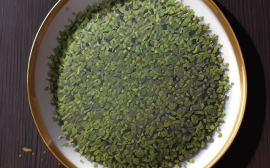Introduction: The Dawn of a New Tea Era
The world of tea is experiencing a profound and luxurious transformation, evolving from the ubiquitous mass-produced tea bag into a realm of unparalleled sophistication and artisanal craftsmanship. A new wave of emerging brands is brewing a premium tea experience, elevating the ancient beverage into a contemporary luxury item. These brands are redefining the very essence of tea, focusing on rare and exquisite cultivars, innovative processing methods that unlock nuanced flavor profiles, and bespoke packaging that exudes opulence.
This shift caters to a discerning, global clientele seeking not just a beverage, but an experience—one that encompasses unique flavors, ethical sourcing, and a deeper connection to the rich cultural heritage of tea cultivation. The burgeoning luxury tea market reflects a growing consumer desire for authenticity, exclusivity, and a return to time-honored traditions, all packaged in a modern, sophisticated aesthetic. This renaissance in tea culture is driven by several key factors. Firstly, increasing disposable incomes, particularly in emerging markets like China and India, are fueling demand for premium goods and experiences.
Consumers are more willing to invest in high-quality products that offer a sense of indulgence and exclusivity. Secondly, a growing awareness of health and wellness has positioned tea as a healthy alternative to sugary drinks and alcoholic beverages. Luxury tea brands are capitalizing on this trend by emphasizing the natural health benefits of their products, further enhancing their appeal. Thirdly, the desire for unique and personalized experiences is driving the demand for rare and specialty teas.
Consumers are increasingly seeking out teas with distinct flavor profiles and compelling origin stories, much like the connoisseur pursuit of fine wines. These emerging brands are pioneering a new era of tea appreciation, introducing consumers to the world of single-origin teas, ancient tea trees, and innovative processing methods like cold-brewing. Imperial Tea Garden, for instance, specializes in exclusive single-estate Darjeeling teas grown in the foothills of the Himalayas. Their commitment to quality extends from meticulously hand-picked leaves to traditional processing techniques, resulting in exquisite teas with delicate muscatel notes.
Similarly, Tealuxe sources rare Chinese teas like “Silver Needle” white tea and aged pu-erh from remote regions, offering consumers a taste of history and tradition. The Tea Alchemist, another prominent player in this luxury market, utilizes innovative cold-brew methods to extract subtle flavors and aromas, creating a truly unique sensory experience. These companies are not merely selling tea; they are curating a lifestyle centered around the appreciation of quality, craftsmanship, and the rich cultural heritage surrounding this ancient beverage.
The innovative processing methods employed by these brands further contribute to the luxury tea experience. Beyond traditional methods, experimentation with cold-brewing, nitrogen infusion, and unique withering processes are yielding teas with unprecedented complexity and depth of flavor. These innovative techniques allow for greater control over the final product, enabling brands to create bespoke flavor profiles that cater to the discerning palates of their clientele. Moreover, these brands often collaborate with tea masters and sommeliers to develop unique blends and tasting experiences, further enhancing the luxury appeal and educational value of their offerings.
The luxury tea market is experiencing a global surge in popularity, with significant growth observed not only in established markets but also in emerging economies. This trend is particularly pronounced in Asia, where tea consumption has deep cultural roots. The increasing demand for premium tea is creating new business opportunities and attracting investment in the sector. Market analysis suggests that this trend is poised for continued growth, as consumer preferences increasingly shift towards experiences and products that offer quality, authenticity, and a connection to heritage.
Emerging Brands: Pioneering the Luxury Tea Movement
“Several brands are spearheading a renaissance in luxury tea, redefining the very essence of this ancient beverage. They are catering to a discerning clientele that seeks not just a drink, but an experience, a journey into the heart of exceptional tea craftsmanship. One such pioneer, “Imperial Tea Garden,” focuses on the rarified world of single-estate Darjeeling teas cultivated in the foothills of the Himalayas. Their commitment to quality extends from meticulously hand-picked leaves to traditional processing methods, resulting in exquisite flavors that capture the unique terroir of their high-altitude gardens.
This exclusivity resonates with luxury consumers who appreciate the provenance and artistry behind their purchases. Recent market analysis shows a significant increase in demand for such single-origin teas, reflecting a growing appreciation for transparency and traceability within the luxury beverage sector. “Imperial Tea Garden’s” limited production runs and bespoke services further enhance their appeal to this exclusive market segment. Another notable player, “Tealuxe,” has carved a niche for itself by specializing in rare Chinese teas.
Their offerings include the delicate “Silver Needle” white tea and the richly nuanced aged pu-erh, sourced directly from small-scale farms committed to sustainable practices. This direct sourcing model not only ensures the quality of their teas but also fosters a sense of ethical consumerism that resonates with today’s luxury buyer. “Tealuxe” emphasizes the cultural heritage behind each tea, offering educational resources and curated tasting experiences that deepen the consumer’s connection with the product. This focus on cultural storytelling aligns with the growing trend of experiential luxury, where consumers seek authentic and meaningful interactions with the brands they patronize.
Experts predict that this emphasis on provenance and cultural narrative will continue to drive growth in the premium tea market. “The Tea Alchemist,” on the other hand, embraces innovation, pushing the boundaries of traditional tea blending. They artfully combine rare teas with unexpected ingredients like saffron, rose petals, and exotic spices, creating unique flavor profiles that appeal to adventurous palates. Their experimentation extends to modern processing techniques, such as cold-brewing, which extracts subtle nuances and delivers a smoother, more refined cup.
This innovative approach resonates with a younger demographic of luxury consumers who seek novel and exciting experiences. “The Tea Alchemist’s” bold, contemporary packaging further reinforces their brand identity as a disruptor in the luxury tea space. Industry analysts note that this willingness to experiment with flavor and presentation is crucial for attracting new consumers to the premium tea market. Furthermore, the rise of luxury tea brands reflects a broader cultural shift towards wellness and mindfulness.
Consumers are increasingly seeking premium beverages that offer both pleasure and health benefits. The rich antioxidant properties and calming effects of tea align perfectly with this trend, making it a natural choice for health-conscious consumers. This convergence of luxury and wellness is further amplified by the growing popularity of tea rituals and ceremonies, which offer a moment of tranquility and self-care in today’s fast-paced world. The focus on mindfulness and self-care is expected to continue shaping the future of the luxury tea market, driving demand for premium teas and related experiences.
Finally, the success of these emerging brands highlights the importance of building a strong brand narrative. Each of these companies has crafted a unique story that resonates with their target audience, communicating their values and commitment to quality. Whether it’s the emphasis on tradition, sustainability, or innovation, these brands have created a distinct identity that sets them apart in the competitive luxury market. This focus on brand storytelling is essential for building customer loyalty and creating a lasting emotional connection with the consumer. As the luxury tea market continues to evolve, the ability to tell a compelling brand story will be a key differentiator for success.”
Rare Cultivars and Innovative Processing: The Pursuit of Excellence
The foundation of the luxury tea movement lies in an unwavering commitment to exceptional ingredients. Emerging tea brands are not merely sourcing tea leaves; they are actively cultivating and curating a selection of rare cultivars that redefine the very essence of premium tea. Imperial Tea Garden, for instance, meticulously nurtures specific Darjeeling clones, some of which are decades old, prized for their distinctive muscatel notes and complex aromatic profiles. These aren’t mass-produced commodity leaves; they are the result of years of careful cultivation, often at high altitudes and in unique microclimates, reflecting a terroir-driven approach more commonly associated with fine wines.
This dedication to the provenance of each leaf is a cornerstone of their brand’s luxury positioning and appeals directly to the discerning tea consumer seeking authenticity and exclusivity. Tealuxe, on the other hand, distinguishes itself by venturing into the remote, often inaccessible regions of China to source ancient tea trees. These trees, some centuries old, yield leaves with a depth of flavor and complexity that cannot be replicated by younger plants. The ‘Silver Needle’ white tea, for example, is hand-picked during a very short window each spring, ensuring only the most tender buds are harvested.
This rigorous selection process, coupled with the tea’s limited availability, elevates it to a status of near-mythical allure among tea connoisseurs. Such sourcing practices are not just about flavor; they represent a commitment to preserving the heritage and biodiversity associated with tea cultivation, adding a layer of cultural richness to the luxury tea experience. This focus on rare, heritage cultivars is a key differentiator in the competitive luxury tea market. The pursuit of excellence extends beyond sourcing to encompass innovative processing techniques.
The Tea Alchemist, for example, has gained recognition for its pioneering cold-brew methods. Unlike traditional hot-water infusions, cold brewing extracts flavors and aromas more subtly, resulting in a smoother, less bitter cup. This technique is particularly effective with delicate blends, allowing the nuanced flavors of each ingredient to shine through. The brand’s approach demonstrates a willingness to experiment with established norms, pushing the boundaries of traditional tea preparation. This innovative approach is not just about flavor; it also appeals to a modern consumer who values creativity and a unique experience.
This resonates strongly with the lifestyle and beverage preferences of the target demographic. Furthermore, the commitment to quality in the luxury tea market is inextricably linked with sustainable farming practices and ethical sourcing. Consumers are increasingly conscious of the origins of their products and the impact of their purchases on the environment and local communities. Brands like Imperial Tea Garden are actively involved in supporting local farmers and promoting sustainable agricultural practices. They often work directly with growers, ensuring fair prices and promoting biodiversity within tea-growing regions.
This transparent and ethical approach not only enhances the brand’s image but also resonates with a growing segment of consumers who prioritize social responsibility alongside quality and luxury. This is a critical aspect of the business model for emerging tea brands aiming for long-term success in the luxury market. Beyond the leaves themselves, the understanding of tea quality assessment is critical. Luxury tea brands employ expert tea tasters and quality control specialists who meticulously evaluate each batch of tea for its appearance, aroma, and flavor profile.
This rigorous process ensures that only the highest-quality tea reaches the consumer. This meticulous attention to detail is a hallmark of the luxury sector, where every aspect of the product is scrutinized to meet the expectations of discerning clientele. These practices contribute to the overall premium experience and justify the higher price points associated with luxury tea. The investment in quality assessment demonstrates a commitment to delivering a superior product consistently, which is crucial for establishing trust and loyalty within the luxury tea market.
Luxury Packaging and Branding: Elevating the Sensory Experience
More than just a container, the packaging for luxury tea has become a crucial element in conveying the brand’s narrative and enhancing the consumer’s sensory journey. It’s an extension of the meticulous care taken in cultivating and processing the rare tea leaves, reflecting the brand’s commitment to quality and craftsmanship. Imperial Tea Garden, with its handcrafted wooden boxes adorned with intricate designs, evokes a sense of tradition and heritage, appealing to consumers who value authenticity and artistry.
These boxes, often made from sustainably sourced wood, speak to the brand’s respect for both cultural heritage and environmental responsibility, key concerns for the modern luxury consumer. The intricate details, inspired by traditional Asian motifs, transform the act of opening the tea into a ritualistic experience, adding a layer of cultural significance to the enjoyment of the beverage. Tealuxe, on the other hand, embraces minimalist elegance with its sleek tins. This understated approach emphasizes the purity and rarity of the teas within, resonating with consumers drawn to clean aesthetics and a focus on the essential.
The tins, often featuring subtle embossing or delicate color palettes, convey a sense of sophistication and restraint, mirroring the refined flavors of the premium teas they contain. This minimalist approach also aligns with sustainable packaging trends, appealing to environmentally conscious consumers in the luxury market. The Tea Alchemist’s bold, contemporary packaging reflects its innovative approach to tea blending and processing. The use of vibrant colors, geometric patterns, and unconventional materials creates a visual language that speaks to a modern, adventurous tea drinker.
This packaging strategy effectively targets a younger demographic within the luxury tea market, those who appreciate novelty and are open to experimenting with unique flavor profiles. The striking visuals also enhance shelf visibility in a competitive retail landscape, further bolstering the brand’s market presence. Across the luxury tea market, packaging plays a crucial role in communicating brand values and enhancing perceived value. Market research indicates that premium packaging significantly influences purchasing decisions in the luxury goods sector, with consumers willing to pay a premium for products presented in high-quality, aesthetically pleasing packaging.
This trend extends to the tea industry, where brands are increasingly investing in sophisticated packaging to elevate the consumer experience and justify the higher price point of their premium offerings. Furthermore, luxury tea packaging often incorporates elements of storytelling, with labels and inserts providing information about the tea’s origin, cultivar, and processing methods. This educational aspect adds another layer of value for the discerning tea consumer, transforming the simple act of brewing a cup of tea into an enriching cultural experience. This approach also caters to the growing consumer demand for transparency and traceability in the food and beverage industry, enhancing trust and brand loyalty. Ultimately, the packaging of luxury tea is an integral part of the overall brand experience, contributing significantly to the product’s perceived value and appeal in a competitive market.
Conclusion: The Future of Luxury Tea
The ascendance of luxury tea signifies a profound shift in consumer values, reflecting a heightened appreciation for not just the beverage itself, but the artistry, heritage, and unique experiences it embodies. These emerging tea brands are adeptly tapping into this desire, moving beyond the commoditized tea market to offer a product that resonates with discerning palates and aspirational lifestyles. They are not merely selling tea leaves; they are curating a holistic experience, complete with stories of origin, meticulous cultivation practices, and an emphasis on the cultural significance of tea.
This transformation is evident in the increasing willingness of consumers to invest in premium tea, viewing it as an indulgence comparable to fine wine or artisanal coffee. The demand for luxury tea is fueled by a desire for authenticity and a connection to the traditions behind this ancient beverage, a trend particularly noticeable among affluent demographics in both established and emerging markets. These innovative brands are also reshaping the tea market by focusing on rare tea cultivars and innovative processing methods.
For instance, consider the growing popularity of single-origin teas, where the terroir and specific varietals impart distinct flavor profiles, much like fine wines. Brands are now actively seeking out ancient tea trees in remote regions, employing traditional hand-picking techniques, and experimenting with new fermentation and oxidation processes to create teas that are truly exceptional. The meticulous attention to detail in every step of the production process, from the tea garden to the final cup, is a testament to the dedication of these artisans.
This pursuit of excellence elevates the tea experience from a daily ritual to a sensory exploration, appealing to consumers who value both quality and the unique story behind their beverages. The focus on tea quality assessment, including sensory analysis and chemical profiling, further underscores this commitment to superior products. The emphasis on luxury packaging and branding is another key factor driving the success of these emerging tea brands. The packaging is no longer an afterthought but an integral part of the overall experience, designed to reflect the premium nature of the tea within.
Handcrafted wooden boxes, elegant minimalist tins, and contemporary, bold designs are all employed to create a visual appeal that resonates with the brand’s identity. These packaging choices not only protect the delicate tea leaves but also serve as a statement of sophistication and exclusivity, further solidifying the brand’s position in the luxury market. The investment in high-quality packaging demonstrates an understanding of the consumer’s desire for a complete sensory experience, where the presentation of the product is as important as its taste and aroma.
This focus on aesthetic appeal is critical in attracting the attention of luxury consumers who are accustomed to high standards of design and presentation. Furthermore, the growth of these emerging tea brands is significantly influenced by evolving tea consumer behavior and broader tea market trends. There’s a growing global consciousness regarding ethical sourcing and sustainable practices, which these brands are increasingly prioritizing. Consumers are not just seeking superior quality; they are also interested in the story behind the product, including the conditions under which it was produced and its impact on local communities.
Brands that demonstrate a commitment to fair trade, environmental sustainability, and community development are gaining a competitive edge in the market. This trend is particularly pronounced in affluent markets, where consumers are willing to pay a premium for products that align with their values. This demonstrates that the future of the luxury tea market will be defined by a combination of exceptional quality, ethical production, and compelling storytelling, all delivered through a sophisticated brand experience.
Ultimately, the luxury tea movement represents a fundamental shift in how tea is perceived and consumed. It’s no longer just a beverage; it’s a cultural artifact, a symbol of refined taste, and a conduit for unique experiences. The emerging tea brands are not just selling tea; they are offering a journey, an exploration of flavors, and a connection to the rich history and traditions of tea cultivation. As the demand for premium tea continues to grow, these innovative brands are well-positioned to not only redefine the future of the tea industry but also to shape the way consumers engage with this ancient beverage. This evolution underscores the importance of craftsmanship, quality, and authenticity in the modern luxury landscape, highlighting the potential for niche markets to thrive by catering to discerning consumer preferences.



